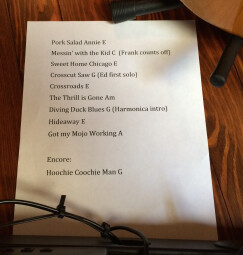A well thought out setlist is critical to the success of your gig. Whether for a band or a solo singer, the order in which you play your songs could mean the difference between a good show and a great show. A poorly constructed set list can cause the audience to turn off in the middle of your show.
Categorize your material
A good way to get started with creating your setlist is to make a master list of all the songs you have available to play for the gig. After the song names, write down their key and their approximate tempo. For the latter you can either put down BPM settings or just classify them as slow, medium or fast. With your songs categorized that way, it will be easier to assemble your set (or sets).
No matter what type of venue you’re playing, or what kind of music you do, you want to grab the audience right from the start, hold their attention throughout the set, bring the whole thing to a crescendo at the end, and leave the wanting more.
If you’re sharing a bill with other bands, make sure to find out how many minutes you’ll be allowed for your set, so that you can plan accordingly. It may change at the gig, due to other bands running long or short, but at least you’ll be starting with the most accurate estimation possible of your set’s duration.
First things, first
In order to get the audience on your side right away, you need a strong first song. In music, as in everything else, first impressions are everything. That said, there are some factors to consider when choosing your opening song.
First, if this is a gig where you’re on a multi-band bill and you won’t be getting a proper soundcheck, your first song will essentially function as one. Unless you’re really used to playing this particular venue, you’ve got to assume that it’s going to take a few songs to adjust to the sound in the room, even if you do get a reasonable soundcheck.
Therefore, it’s important to choose a first song that you can play in your sleep. This is not the place to debut a new song or play a song that has tricky vocal harmonies, because odds are you won’t be adjusted to the monitor levels as of yet. You’re likely to be distracted to some degree by the sonic situation on stage, so you don’t want to have to think about the arrangement or try to remember your part. It’s also probably wise to go with something tried and true for the second song, because it will likely take you at least a couple of songs to get comfortable with the sound.
The set continues…
Once you’ve decided on a couple of strong-but-comfortable songs to begin the set with, start compiling the remainder of the setlist, keeping in mind that you want to: A) keep the audience’s attention throughout the set and B) showcase your best material.
Factor in tempo and key, in that order of importance. It’s not the end of the world to have two songs in the same key back to back. You have to be more careful when it comes to tempo, however. Try to avoid putting several slow-to-medium tempo songs in a row, because the crowd might lose interest. As you get towards the end of the set, try to build up to the last song. From high energy to even-higher energy.
If you’re a mellow acoustic act, the high-energy aspect might not be as applicable, but you still want to keep things from dragging. You can substitute intensity for high energy, if you material is mostly quiet.
A couple of additional factors to consider when deciding on your order: If you have more than one lead singer in your band and you split the lead vocals pretty evenly between the two singers, you probably don’t want to do more than two songs in a row sung by the same person, if possible. Also think about who starts and who ends the set.
If your group plays cover material and some of your songs are on the obscure side while others are more recognizable, don’t go with too many obscure ones in a row. The same principle holds true if you mix in original material with covers. Try to strategically place your originals in and around the covers, rather than do several consecutively.
If you’re doing more than one set, treat each set as an independent show, but also keep the big picture in mind. If you’re playing a club that tends to fill up more after the first set, hold a lot of your strongest material for the later set (or sets). If the earlier sets are better attended, then don’t save your best stuff. You want to play your top material while the biggest audience is there.
Finally, choose a song to use for a potential encore so you don’t waste time standing around on stage trying to figure out what to play.
Putting it on paper
Once you’ve figured out your list, it’s always helpful to print out a copy for each band member, using as large a font as possible while keeping the set list to one page (per set). Also include keys and any special notes — for instance if somebody different than normal counts off a particular song, so that everyone remembers.
Keep the time between songs at a minimum in order to keep the momentum of the set going. Too much wasted time between songs will extend the time of your set, and you run the risk of getting told the dreaded “last song” directive from the club when you still have several songs left in your carefully planned set.

